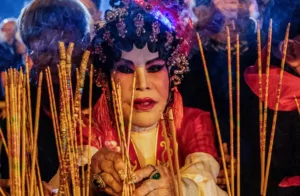Lunar New Year is one of the most significant cultural celebrations across East Asia and beyond. From family gatherings and vibrant lion dances to social debates and shifting traditions, the festival reflects both deep-rooted customs and modern societal changes.
The Rise of the “Fashionable Aunt” in China
A New Symbol of Independence
A new trend is gaining momentum this Lunar New Year: the “fashionable aunt” (时髦阿姨). The term, which first appeared on Xiaohongshu in late 2022, has gone viral, amassing millions of views. It celebrates women who are confident, stylish, and unbothered by traditional pressures to marry and have children early.
In Chinese society, where unmarried women in their late twenties are often labeled “leftover women”, family gatherings during the Spring Festival can bring uncomfortable conversations. But the “fashionable aunt” represents an empowered alternative.
Public Reactions
- Inspired Generations: A 17-year-old user shared, “My single aunt, a stylish business manager in Beijing, inspired me with her confidence when relatives pressured her about marriage.”
- Pushback Against Stereotypes: Others argue the trend creates another social expectation. One viral post stated, “True independence isn’t about fashion—it’s about staying true to yourself.”
Sydney’s Lion Dance: Bringing Tradition to Life
A Performance That Connects Generations
In Sydney’s Chinatown, the lion dance is a highlight of the city’s 19-day Lunar New Year celebrations. Beneath a traditional gate, young performers bring the mythical lion to life through synchronized movements, led by Shifu Edison.
The Art Behind the Dance
- Physical Demands: Alex, a performer since age five, explains, “You have to use all parts of your body. Footwork helps, but together, it makes the lion come alive.”
- Cultural Importance: Robert Kok, Sydney City Councillor, describes Lunar New Year as “the most important cultural day for my community and for me personally.”
From dragon boat races to Korean dancefloors, Sydney’s celebrations showcase the festival’s multicultural influence.
Lonely Lunar New Year: Hong Kong’s Aging Population
Elderly Left Behind as Families Migrate
For many elderly Hong Kongers, Lunar New Year is now a quieter and lonelier affair.
Ah Chu, 78, recalls when her home was filled with laughter and a feast for the New Year. “Now, with my daughter in the UK, there’s no point in preparing elaborate meals.”
The Migration Wave’s Impact
- Mass Emigration: Following political changes and the National Security Law, Hong Kong has seen a rise in migration, leaving many elderly parents behind.
- Alarming Statistics: Government data shows a 60% increase in elderly people living alone over the past decade, with 188,000 seniors now in solitary households.
- Community Support: NGOs have stepped in, organizing group activities like hotpot dinners to bring comfort.
Despite the shift, many seniors are finding ways to adapt to their new reality.
Lunar New Year vs. Chinese New Year: A Heated Debate
The Cultural Naming Dispute
The festival is known by different names:
- Chunjie (春节) – Chinese
- Seollal (설날) – Korean
- Tet (Tết Nguyên Đán) – Vietnamese
While “Lunar New Year” is widely used, some argue that the term erases China’s influence, as many of the traditions originated there. On the other hand, using “Chinese New Year” can feel exclusionary to Koreans, Vietnamese, and other cultures who celebrate it differently.
The Online Battle
- Pro “Chinese New Year” Side: Advocates claim calling it “Lunar New Year” downplays its Chinese roots.
- Pro “Lunar New Year” Side: Others argue that different cultures celebrate it uniquely and shouldn’t be overshadowed.
The debate continues, highlighting how cultural identity and language remain sensitive topics.
Red vs. White: Color Symbolism in the New Year
The Meaning of Colors Across Asia
Different cultures assign unique meanings to colors in Lunar New Year traditions:
- China: Red symbolizes good fortune and joy. Hanging red banners and wearing red clothing are believed to ward off evil spirits, inspired by the mythical beast Nian (年兽).
- South Korea: White represents purity and a fresh start. While Chinese elders give money in red envelopes, South Koreans prefer white envelopes.
These cultural distinctions add richness to the way the festival is celebrated across different regions.
A Festival of Transformation
Lunar New Year remains a time of family, food, and tradition, but it also reflects the changing social landscape. From empowered women defying old norms to elderly Hong Kongers adjusting to solitude, each story sheds light on how this ancient festival continues to evolve in modern times.
Source BBC.COM
















